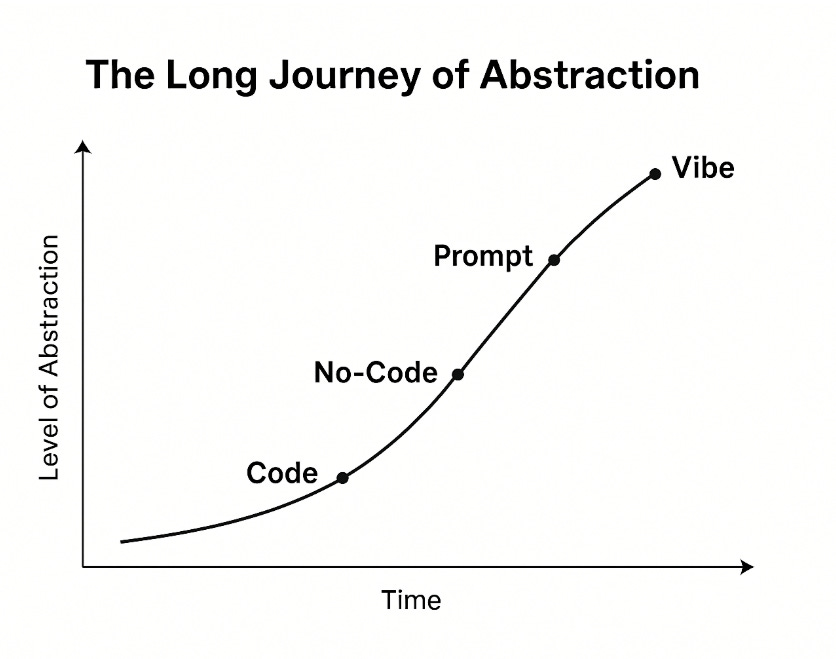The Future of Vibe Coding
Coding by mood, not method
Once, we told computers exactly what to do. Now, we just tell them how it should feel.
Welcome to the age of vibe coding; where software isn’t built line by line but vibe by vibe. You don’t specify a flow; you set a mood. “Make it trustworthy but futuristic,” you say, and the system generates something that simply feels right. It sounds unserious, but it marks a deeper shift in how humans and machines collaborate.
A vibe is GenZ shorthand for how something feels; less about precision, more about resonance. It’s the creative hunch before the spec sheet. A “startup vibe” might mean bright typography and optimism; a “NASA vibe” might mean quiet precision. You don’t dictate, you gesture; and the system fills in the blanks. For the first time, the machine can respond in kind.
Vibe coding is the latest stop in a long journey of abstraction: code → low-code → no-code → prompt → vibe. Each step moves us from syntax to intention. We live in a world saturated with software. Functionality is cheap; taste is rare. The bottleneck has shifted from skill to clarity of intent. Vibe coding is what happens when describing what you want matters more than how to make it.
It’s still early. Vibe coding today is inconsistent, subjective, sometimes brilliant, often chaotic. Like any creative medium, it’s still finding its structure. Over time it may need to develop vibe guidelines or vibe systems - loose grammars for expressing intention without killing spontaneity. But these are metaphors, not blueprints. The form it takes will depend on the people who use it - and what they choose to call good.
Vibe coding today feels most natural in prototyping, creative tools, and personal automations; places where experimentation beats precision. It could serve enterprises too, as a translation layer between business intent and engineering detail: “Make our product feel more human.” It won’t replace code; it expands who gets to create.
If you push vibe coding further, what happens when the boundaries dissolve? Will voice become the new prompt after text - where you talk, the system builds, and the dialogue itself becomes part of the design? What if tools grew emotionally aware, sensing hesitation or enthusiasm and adjusting accordingly? Could taste become a data source, feeding in playlists, boards, even the cadence of your writing, with the system composing around your aesthetic fingerprint? What about biometric loops, where your pulse or gaze steers creative decisions? Or temporal vibes, apps that evolve their tone with the seasons? Could teams and AI agents riff together in real time - not in sprints, but in jam sessions? Might we sculpt workflows in 3D space, or one day simply think a mood and watch it take form? And when that happens — does the compiler become a collaborator, or a mirror, reflecting not just intention but imagination?
For most of computing history, power belonged to those who could command machines precisely. The new power may belong to those who can inspire them effectively. The best builders might not be the best engineers, but those with the sharpest sense of taste. Coding turns from control to curation; a medium for expression rather than execution.
Maybe vibe coding won’t build apps at all but behaviors. Instead of “build me a CRM,” you’ll say, “make my business feel more responsive.” The system will adapt tone, workflow, and experience to match; software as a self-tuning instrument. The goal isn’t code that follows instructions. It’s code that keeps intention alive.
We used to code for machines. Now we describe the worlds we want and they start to appear. The challenge isn’t whether machines can understand us. It’s whether we can articulate what we actually mean.



